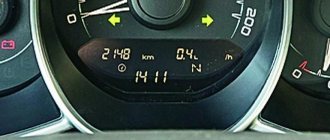↑ Determination of clearance
First, it’s worth understanding what the clearance of the Lada Vesta is. We are talking about ground clearance, that is, the distance from the surface of the earth to the lowest protruding point of the car. Since the vehicle is produced in Russia, the condition of the roads in the country was taken into account during its development. Thanks to this, the car turned out to be quite tall. But it’s worth figuring out what indicators relate to the car.
How to increase the ground clearance of the Lada Vesta SV Cross?
For those for whom the ground clearance of the Lada Vesta SV Cross is not enough, there is the opportunity to make it a little larger. In order to increase Vesta's ground clearance, you can resort to minor modifications. The rear section lifts up quickly and easily. To do this, you need to purchase special spacers for the racks. They are metal plates that are placed under the rack support. All modifications are made in 15-20 minutes and do not require professional qualifications. With this modification you can raise Vesta Cross SV by 2-3 cm.
In the case of the front struts, everything is somewhat more complicated. But nothing is impossible. the principle of raising Vesta above the road comes down to similar actions. You just need to buy a spacer for the front strut support.
Please note that increasing the ground clearance of the Lada Vesta SV Cross using such actions is subject to changes in the design of the car. Therefore, do everything at your own peril and risk. However, 99% of the time, not a single employee, when checking a car, will crawl under the car to identify the illegal installation of spacers.
↑ Standard ground clearance indicators
If you look at the documents, you can easily understand what ground clearance the Lada Vesta has. It is believed that the distance from the engine crankcase to the ground is 171 mm. If you look at the height from the engine mudguard, the ground clearance will be 144 mm. These measurements were taken on 16-inch wheels. If the car has tires of a different size, then the ground clearance will change. For example, if 15-inch wheels are installed, the distance will be 165 mm to the crankcase and 138 mm to the mudguard.
Vesta factory tires and wheels
If you decide to replace the standard wheels and tires on a Lada Vesta, then rely on the full diameter of the wheel. How to do this, using 185/60 R14 as an example:
- A disk with a diameter of 14″ is equal to 14 * 25.4 (1 inch = 2.54 cm) = 355.6 mm.
- The height of the tire profile is calculated as follows: 185*60/100=111 mm. Add up the rim diameter and the two tire profile heights: 355.6 111 * 2 = 577.6 mm.
The green color indicates the minimum deviation of the wheel diameter (up to 3 mm); Orange indicates a diameter deviation from 3 to 6 mm.
When installing tires or wheels that differ in parameters from those recommended by the factory, you can:
- be refused warranty repair of the chassis;
- be stopped by a traffic police inspector, who has the right to draw up a report on the car’s non-compliance with the requirements of the Technical Regulations;
- fail to pass technical inspection.
| Increasing disc diameter | Increasing rim width | Increasing tire width | |
| Car style | will improve | will improve | will improve |
| Road holding | will improve | will improve | will improve |
| Steering precision | will improve | will improve | will improve |
| Tire grip | Will not change | Will not change | will improve, but only on dry roads |
| Resistance to hydroplaning | Will not change | Will not change | will get worse |
| Comfort on rough roads | will get worse | Will not change | will improve |
| Road noise | Will not change | Will not change | will intensify |
| Gasoline consumption | Will not change | will increase | will increase |
| Tire wear | Will not change | Will not change | will increase |
If you are going to buy winter tires for your Lada Vesta, then try to choose narrower tires. These tires will create more pressure on the road surface and improve traction. Remember that wide tires are more sensitive to ruts in winter. And low-profile tires make the ride less comfortable, because... transfer even the smallest holes to the body.
The smaller the unsprung mass (this includes the mass of tires and wheels), the better the car will hold the road and accelerate faster. For example, if you put wheels on a car that are 2 kg lighter each, then acceleration to 100 km/h will be reduced by 0.2 seconds.
What wheels and tires did you choose for the Lada Vesta? What are the pros and cons of such a replacement? Participate in the survey, leave feedback and ask questions. Let us remind you that in this article we determine the real fuel consumption of this car.
↑ Clearance parameters
Above were the ground clearance parameters for the Lada Vesta when loading. As for an empty car, its indicator will be from 171 to 178 mm. There may be higher rates. In general, the manufacturers made sure that the sedan was quite “tall”. Otherwise, it will simply cling to the road with its bottom, which no driver will like. You can measure the distance not only to the crankcase or mudguard. For example, the clearance to the muffler is 18.7 cm.
↑ At full load
The concept of full load implies that the car contains a driver, passengers, and cargo. The sedan can withstand a maximum load of 400 kilograms. This is also reflected at a distance to the surface of the earth. It was already said above that when the car is fully loaded, its value will be 14.4 or 17.1 cm, depending on the location of measurement. It is important to understand that the real ground clearance of the Lada Vesta depends on exactly how loaded the car is. If there is a driver and a passenger in the car, but there is no cargo, then the ground clearance will differ from the declared one.
Does the 1.8 Lada Vesta Cross engine bend valves when the timing belt breaks?
Lada Vesta SV Cross what color to choose
The answer is yes! The 1.8 Lada Vesta Cross SV engine with index 21179 bends the valve when the timing belt breaks. This is a characteristic feature of any modern engine. The thing is that modern cars are trying to squeeze out maximum power without increasing engine size. This is done by lightening the connecting rod and piston group, as well as increasing the compression ratio. In this case, it is impossible to make grooves in the pistons so that if the timing belt breaks, they do not meet the valves. Therefore, if the pump, tension roller jams, or simply breaks the belt, a major engine overhaul is inevitable.
Many people are probably wondering what parts were used to assemble the 21179 motor. Now we’ll talk about this.
1. Timing belt - Continental. Manufacturers claim that the belt life is about 180 thousand km. I doubt that this is real, but these are the stated figures. Read it yourself here. 2. Injectors - Continental. These injectors have a longer service life than the Priora and also have increased productivity. 3. Valves - Mahle. 4. Pump - GMB. The resource is the same as that of the timing belt - 180 thousand km. 5. Oil pump - GMB. Has improved performance. 6. Camshafts - Toyota Tsusho. The decision to use these RVs was due to the fact that the old cast iron RVs were heavier than Toyota ones. 7. INA phase adjustment mechanism.
Features of the 1.8 engine Lada Vesta SV Cross 2017
Externally, the 21179 engine is very similar to other 16-valve VAZ and . But it was possible to achieve a volume of 1.8 liters not thanks to an increase in the diameter of the cylinders, but to an increase in the piston stroke in a standard cylinder. To do this, it was necessary to rework the entire connecting rod and piston group, and also install a new crankshaft.
In addition, 21179 is the first VAZ engine to use variable valve timing.
The 1.8 Vesta engine also differs from previous versions in that it has completely redesigned oil and cooling channels.
Due to the increase in engine volume, it was necessary to install new injectors with higher performance, an enlarged throttle valve, and also increase the volume of oil in the engine. The oil pan now holds 4.4 liters of engine oil, and a more efficient oil pump is located under the crankcase. The intake ports are also larger than before.
Another characteristic feature of the 21179 engine was the abandonment of the classic model of using a mass air flow sensor. Now readings are taken using an absolute pressure sensor and an air temperature sensor.
The graph clearly shows that the developers did a very good job tuning the 21179 engine. Already at 4 thousand rpm, the 179 engine produces a maximum torque of 170 Nm, and at 5.5 thousand rpm it produces a maximum power of 122 hp. With.
↑ Car behavior on the road
The sufficient height of the car will definitely be appreciated by motorists living in provincial settlements. This is where severe road problems are usually observed. The high ground clearance of the Lada Vesta from AvtoVAZ allows you to minimize the risk of problems associated with this. But the long distance to the bottom also has disadvantages. It negatively affects the vehicle's handling and maneuverability while driving.
Car manufacturers have tried to reduce the negative consequences of high ground clearance. The vehicle has good steering, thanks to which the car behaves well on the road. The reduction in maneuverability is almost imperceptible.
The suspension on the car has also been carefully planned and designed. It rests on the body through a subframe. Thanks to this state of affairs, Vesta has good driving characteristics. Some compare it with foreign cars, and Lada will even give many foreign cars a head start in terms of characteristics. For example, the Nissan Almera has a height to the bottom of 165 mm. The Peugeot 408 has a ground clearance of 178 mm to the crankcase.
If we compare the parameters of Vesta with domestic analogues, then the ground clearance indicator exceeds the characteristics of other models from AvtoVAZ. There are only two cars that have slightly more ground clearance. We are talking about Kalina 2 and Largus with front-wheel drive. This is why Lada Vesta is so popular today. It is liked by drivers who drive a lot on roads that are not of very good quality.
In a word, the ground clearance of the mentioned sedan is a fairly pleasant indicator for drivers. Even at full load the machine remains quite high. This allows you to drive on uneven roads and even overcome all kinds of obstacles without any problems. It is important to understand that if the load is incomplete, the clearance value will differ from that stated in the documents. If you wish, you can take measurements yourself.
The clearance of the Lada Vesta SV Cross will not allow it to get caught
Toyota Camry ground clearance, real ground clearance of a Russian-assembled Toyota Camry
The latest new car model to appear on our market is the Lada vesta sw cross. The experts' assessment of the vehicle exceeded expectations. Ground clearance reaches 230 mm. Not all crossovers have this distance. Of course, you can’t call it a tall car; it’s not suitable for severe off-road conditions. The characteristics of the car are suitable for rough terrain. Initially, the inventors wanted to build an SUV capable of overcoming any obstacles, but they failed. Insufficient funding for the project played a role. The presented copy did not turn out the way we wanted it to be, we will describe some of the shortcomings:
- firstly, when loading 230 mm, there is no sign of it;
- secondly, the unit is equipped with one front-wheel drive;
- lack of locking systems;
- The installed wheels are not suitable for off-road driving.
For better cross-country ability, it is necessary to provide the vehicle with tires with a wide tread and wheels of a smaller diameter.











